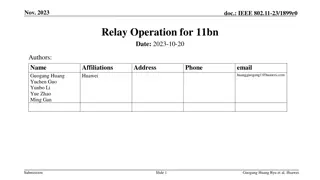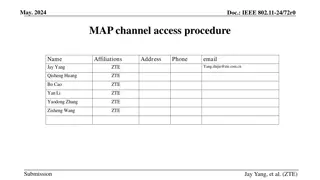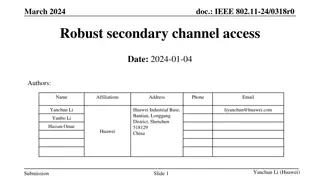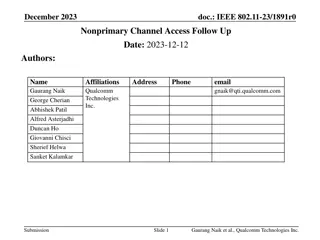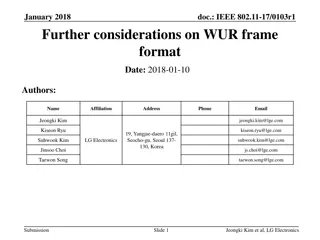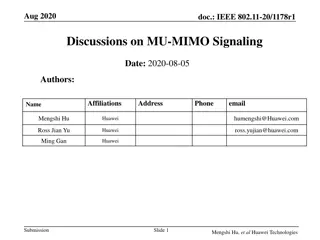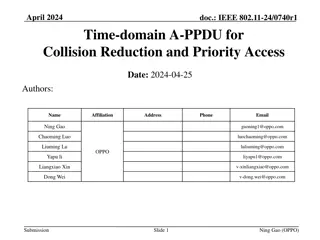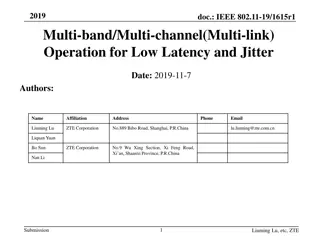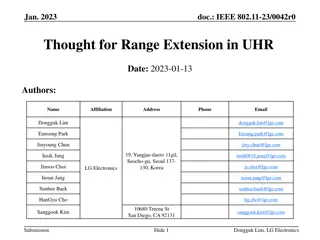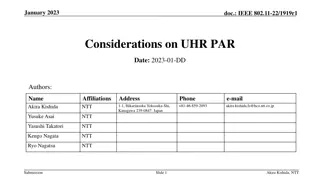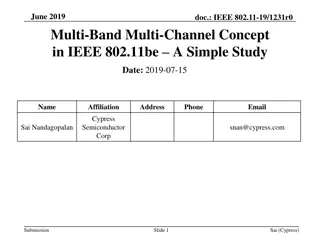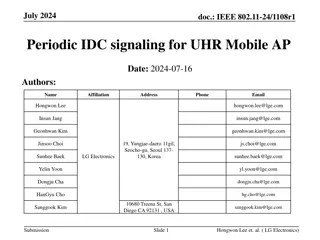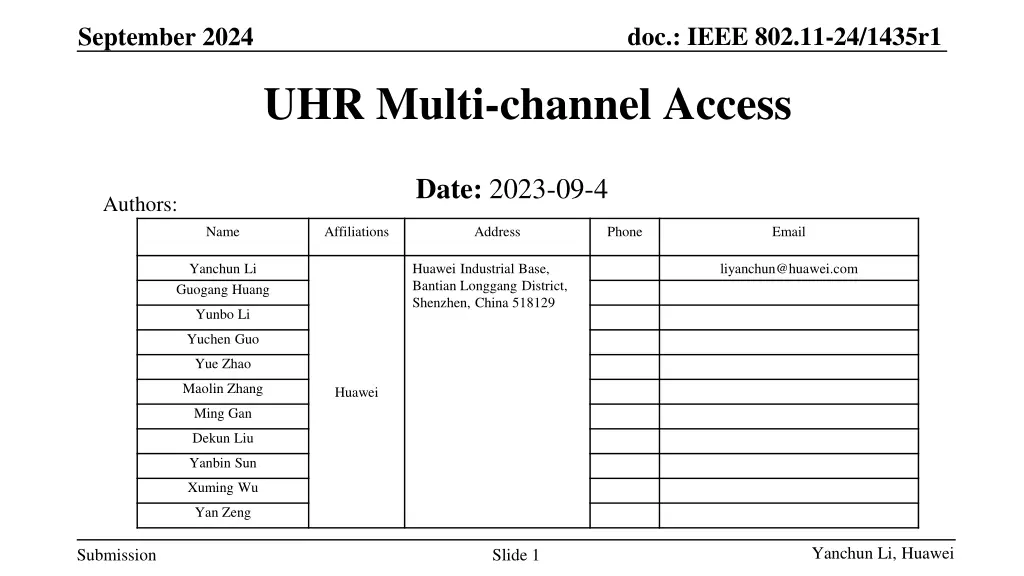
Efficient Multi-channel Access Strategies for Reduced Latency in IEEE 802.11
Explore the efficiency of multi-channel access in reducing latency with uncertain traffic scenarios in the context of IEEE 802.11 standards. Discusses the challenges and potential solutions for deterministic channel occupation information required for link switching decisions. Discover the impact of resource reservation and traffic uncertainty on channel access strategies.
Uploaded on | 2 Views
Download Presentation

Please find below an Image/Link to download the presentation.
The content on the website is provided AS IS for your information and personal use only. It may not be sold, licensed, or shared on other websites without obtaining consent from the author. If you encounter any issues during the download, it is possible that the publisher has removed the file from their server.
You are allowed to download the files provided on this website for personal or commercial use, subject to the condition that they are used lawfully. All files are the property of their respective owners.
The content on the website is provided AS IS for your information and personal use only. It may not be sold, licensed, or shared on other websites without obtaining consent from the author.
E N D
Presentation Transcript
doc.: IEEE 802.11-24/1435r1 September 2024 UHR Multi-channel Access Date: 2023-09-4 Authors: Name Affiliations Address Phone Email Yanchun Li Guogang Huang Huawei Industrial Base, Bantian Longgang District, Shenzhen, China 518129 liyanchun@huawei.com Yunbo Li Yuchen Guo Yue Zhao Maolin Zhang Huawei Ming Gan Dekun Liu Yanbin Sun Xuming Wu Yan Zeng Yanchun Li, Huawei Submission Slide 1
doc.: IEEE 802.11-24/1435r1 September 2024 Introduction UHR PAR has defined the requirement on reduced latency. Multi-channel access is a promissing scheme for this purpose. TGbe has adopted multi-link operation (MLO), while TGbn SFD has accepted non-primary channel access (NPCA). Both of these schemes require deterministic channel occupation information, for link switching/ primary channel switching decision. However, realistic traffic has uncertainty and make multi-channel access challenging. This contribution discusses the multi-channel access efficiency with uncertain traffic. Yanchun Li, Huawei Submission Slide 2
doc.: IEEE 802.11-24/1435r1 September 2024 Background: Resource Reservation can reduce latency Low-latency (LL) Traffic arrival Channel Busy LL Traffic OBSS Tx Primary Channel t Fig.1 Delay due to OBSS channel occupation Low-latency (LL) Traffic arrival Resource Reservation by TWT SP at expected traffic arrival time LL OBSS Tx Primary Channel Traffic t Fig.2 e.g. Coordinated R-TWT Yanchun Li, Huawei Submission Slide 3
doc.: IEEE 802.11-24/1435r1 September 2024 Background (2): Multi-channel Access schemes reduce latency Once an OBSS announces that it will occupy part of channel, AP/STA can switch to non-primary channel or another channel/link. Keep in mind that the original primary channel or primary link is still AP/STA s first (best) choice. NCPA: AP s primary mode AP s secondary mode Logical 20MHz control channel in real-time use S80 S80 (NP) P160 P80 P80 t OBSS occupation MLO (single radio): (assuming STA shares hardware for channel 1 and 2) (DSO is similar) AP s primary mode AP s secondary mode P80 Ch2 P160 P160 Ch1 t Yanchun Li, Huawei Submission Slide 4
doc.: IEEE 802.11-24/1435r1 September 2024 Channel reservation and traffic uncertainty According to AP1 s high-priority application traffic pattern, AP1 can announce its reserve SPs on specific channel in advance. If traffic is absent in some SP, this SP is left blank by AP1. Traffic arrival Traffic arrival Traffic arrival S80 AP1 P80 P80 P80 P80 P80 Announce SP1 SP1 SP1 SP1 Yanchun Li, Huawei Submission Slide 5
doc.: IEEE 802.11-24/1435r1 September 2024 Issue in Basic Multi-channel Access schemes OBSS s R-TWT SP announcement does not always leads to non-primary channel use or channel switching. To support low latency access at expected traffic arrival time, AP1 announces a SP1 (e.g. R-TWT or Coordinated R-TWT SP), or P2P R-TWT To allow STAs to switch accordingly, AP1 announces a SP (e.g. R-TWT or Coordinated R-TWT) which involves secondary channel/link switching. S80 (NP) S80 AP1 AP2 P80 (wasted) P80 Announce Announce SP1 AP1 had announced SP1 on Ch1. But Ch1 is not efficiently used: Case 1: due to lack of traffic, AP1 makes no use of this SP. (AP may transmit CF-End to release this SP.) Case 2: AP1 only needs to transmit to a near STA with low transmit power, the spatial reuse is allowed in SP1. Yanchun Li, Huawei Submission Slide 6
doc.: IEEE 802.11-24/1435r1 September 2024 An Efficient Multi-channel Access operation AP2 can sense channel in the begin period of OBSS s announced R-TWT SP. If AP2 has not detected channel occupation in this period, AP2 can keep using this best channel, instead of switching to less favorable secondary link/non-primary channel. AP2 channel sensing S80 P160 AP1 AP2 CS P80 Announce Announce SP1 AP2 s CS Period AP2 can announce that switch to Ch2 is tentative: o Condition 1: Ch1 is idle during CS period, AP2 keeps using Ch1. o Condition 2: Ch1 is busy, AP2 switches to Ch2. AP2 s CS Period can be a preset duration. Or AP2 announce a value n1, can calculate the duration by SIFS+n1*backoff slot. Yanchun Li, Huawei Submission Slide 7
doc.: IEEE 802.11-24/1435r1 September 2024 STA s behavior to catch up AP s tentative switches AP2 shall initiate transmission on Ch1 before (non-AP) STA s CS period ends. So that STA can detect AP2 s present on Ch1 before STA s CS period ends. If STA has detected AP2 s present on Ch1, STA can communicate with AP2 on Ch1. If not, STA can switch to Ch2. AP2 s ICF frame on Ch1, or PPDU with AP2 s BSS color in Preamble. AP2 channel sensing S80 P160 AP1 AP2 CS P80 Announce Announce SP1 AP2 s CS Period (SIFS+N*slot) STA s CS Period1 Yanchun Li, Huawei Submission Slide 8
doc.: IEEE 802.11-24/1435r1 September 2024 STA s behavior to catch up AP s tentative switches AP2 shall send channel occupation signal on Ch2 within STA s CS Period2. If STA has detected AP2 s present signal on Ch2, within CS period 2. STA keeps on Ch2. Otherwise, STA can switch back to Ch1. AP2 s ICF frame on Ch2, or PPDU with AP2 s BSS color in Preamble. AP2 channel sensing Ch2 S80 AP1 AP2 CS P80 Announce Announce SP1 AP2 s CS Period STA s CS Period1 STA s CS Period2 Yanchun Li, Huawei Submission Slide 9
doc.: IEEE 802.11-24/1435r1 September 2024 Framework for tentative TWT SP channel access OBSS s tentative TWT SP Announcement, e.g. Target Wake Time Spatial Reuse allowed Nominal Minimum TWT Wake Duration Tentative or not TWT Wake Interval Mantissa (new added) AP1 AP2 P80 P80 Announce Announce SP slot2 SP slot1 Yanchun Li, Huawei Submission Slide 10
doc.: IEEE 802.11-24/1435r1 September 2024 Framework for tentative TWT SP channel access Local AP s tentative TWT SP Announcement, e.g. Target Wake Time Tentative or not STA s CS Period1 Nominal Minimum TWT Wake Duration STA s CS Period2 TWT Wake Interval Mantissa (new added) AP2 channel sensing Ch2 S80 AP1 AP2 CS P80 Announce Announce SP1 AP2 s CS Period STA s CS Period STA s CS Period2 Yanchun Li, Huawei Submission Slide 11
doc.: IEEE 802.11-24/1435r1 September 2024 Comparison of switching conditions in multi-channel schemes Triggering Signal for NPCA channel switch Reference Pros Cons OBSS Control Frame Current SFD Synchronization issue: e.g. AP on Primary, STA on Secondary, or vise versa. ICF frame (for MLO/EMLSR/PS) 11be/ 11bn contributions [6] Robust [5] Low latency High efficiency Robust (STAs can receive control frame from their own AP with high probability) Reception of switching indication frame from local AP on Primary channel Timeout of stay-on-primary indication frame from local AP on Primary channel within a specified period this contribution Yanchun Li, Huawei Submission Slide 12
doc.: IEEE 802.11-24/1435r1 September 2024 Conclusions 11bn aims at low latency access for some high-priority traffic. To guarantee contention/deferral free channel access, some OBSS AP may reserve TWT SPs beyond the actual needs. The uncertain arrival of traffic may lead to inefficient use of channel resource in these SPs. Local AP s active switching to a secondary link (or a non-primary channel) can avoid collision with OBSS AP s reserve TWT SPs. But if there are lots of wasted over reserved TWT SPs and , local AP s better choice is to watch OBSS AP s actual occupation in OBSS AP s claimed TWT SPs. So, local AP can avoid unnecessary secondary link (or a non-primary channel) switches. In summary, 11bn shall define a scheme to allow use of leftover TWT SPs for channel efficiency. Yanchun Li, Huawei Submission Slide 13
doc.: IEEE 802.11-24/1435r1 September 2024 Straw Poll 1 Do you agree to define such NPCA behavior in SFD: - OBSS s SP on the primary channel? The BSS can switch to a non-primary channel at a period overlapped with - Y - N - Abs Yanchun Li, Huawei Submission Slide 14
doc.: IEEE 802.11-24/1435r1 September 2024 Straw Poll 2 Do you agree to define tentative SP in SFD to support low latency service in dense deployment scenario: - Tentative SP in multi-channel access scenarios, is a candidate SP which is cancellable on a specific channel, if AP has not presented within scheduled duration in this SP. - Y - N - Abs Yanchun Li, Huawei Submission Slide 15
doc.: IEEE 802.11-24/1435r1 September 2024 Straw Poll 3 Do you agree to define such NPCA behavior in SFD: - AP can announce switching to non-primary channel at the period overlapped with OBSS s SP on primary channel? - Y - N - Abs Yanchun Li, Huawei Submission Slide 16
doc.: IEEE 802.11-24/1435r1 September 2024 Straw Poll 4 Do you agree to define such NPCA behavior in SFD: - AP can announce tentative switching to non-primary channel - AP can insist on primary channel by transmitting TBD PPDU on primary channel, if primary channel is available. - Y - N - Abs Yanchun Li, Huawei Submission Slide 17
doc.: IEEE 802.11-24/1435r1 September 2024 Reference [1] 11-23-1952-00-00bn-coordinated-r-twt-for-multi-ap-scenarios-follow-up, Liuming Lu [2] 11-23-2022-01-00bn-r-twt-for-multi-ap-follow-up, Laurent Cariou [3] 11-23-1932-03-00bn-further-considerations-on-coordinated-twt, Rubayet Shafin [4] 11-24-0742-00-00bn-obss-twt-management-for-map, Pascal Viger [5] 11-24-0318-00-00bn-robust-secondary-channel-access, Yanchun Li [6] 11-24-1587-02-00bn-discussion-on-dso-operation, Kaiying Lu Yanchun Li, Huawei Submission Slide 18





